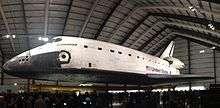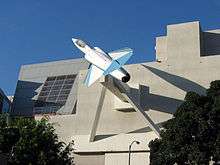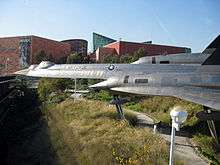California Science Center
 | |
| Established |
1951 as California Museum of Science and Industry 1998 as California Science Center |
|---|---|
| Location | Exposition Park, Los Angeles, California |
| Coordinates | 34°0′56″N 118°17′9″W / 34.01556°N 118.28583°WCoordinates: 34°0′56″N 118°17′9″W / 34.01556°N 118.28583°W |
| Type | Science museum |
| Public transit access |
|
| Website | CaliforniaScienceCenter.org |
The California Science Center (sometimes spelled California ScienCenter) is a state agency and museum located in Exposition Park, Los Angeles, next to the Natural History Museum of Los Angeles County and the University of Southern California. Billed as the West Coast's largest hands-on science center, the California Science Center is a public-private partnership between the State of California and the California Science Center Foundation. The museum is also an affiliate in the Smithsonian Affiliations program.[1]
Founded in 1951 as the "California Museum of Science and Industry", the Museum was remodeled and renamed in 1998 as the "California Science Center".
Admission includes access the permanent exhibits and demonstrations. A separate ticket is required for the IMAX movies, most special traveling exhibitions, and special activities that include a climbing wall, motion simulator and a high-wire bicycle.
The California Science Center hosts the California State Science Fair annually.
The Center has been accredited by the American Alliance of Museums and the Association of Zoos and Aquariums, and is a member of the Association of Science and Technology Centers.
The California Natural Resources Agency oversees the California Science Center and the California African American Museum.
Current permanent exhibits
Ecosystems
The two-story, 45,000-square-foot exhibit features display zones with live animals and aquariums about wildlife and adaptation in different ecosystems, including a river, desert, polar region, deep sea, ocean, island and urban areas, as well as the entire planet Earth.[2]
Creative World
An area with hands-on activities and exhibits that explore innovation and invention, with themes involving construction, energy and transportation.
World of Life
Examines the processes of life and similarities among organisms, including food, body organs like the heart and brain, senses, defenses against threats, how living things reproduce which includes a hatching chick display, DNA, and microscopic organisms.
Air and Space Exhibits

- Space Shuttle Endeavour in the Samuel Oschin Pavilion,[3]
- SKETCH Foundation Gallery in Science Court - exhibits about the solar system, space travel and aviation, displays of historic aircraft, space vehicles and equipment, and space telescopes.
Aircraft
- Douglas DC-8 jetliner
- Lockheed F-104D Starfighter
- Lockheed A-12 Blackbird two-seater trainer, Serial Number 60-6927
- Replica Bell X-1 (movie prop from The Right Stuff)
- 1902 Wright Glider replica
- 1929 Velie Monocoupe
- Northrop T-38 Talon Jet Trainer, Serial Number 58-1196
- Northrop F-20 Tigershark
- McDonnell Douglas F/A-18A Hornet Serial Number 161725
Human Spacecraft
- Capsule for Mercury-Redstone 2 which carried Ham the Chimp into space
- Capsule for Gemini 11
- Apollo-Soyuz Test Project Command Module
- Space Shuttle Endeavour
- Skylab B
Robotic Spacecraft
- Engineering prototype for Viking Lander
- Cassini-Huygens planetary probe (mock up)
- Pioneer 10 planetary probe
- Mariner IV planetary probe
- Pioneer-Venus planetary probe
History
.jpg)
State Exhibition
The museum's history dates back to the first California State Exhibition building, which opened in Exposition Park in Los Angeles in 1912, the site of an agricultural fairground from 1872 to 1910. The brick and terra cotta building, designed by William D. Coates, Jr., state architect, and N. Ellery, state engineer,[4] displayed agriculturally-based natural resources and industrial products from across the state, including ranching, fish and game, coal mining, gold mining, oil production and lumbering, as well as some of the state's recreational attractions.[5] After World War II, the building also featured exhibits about state science and technology industries.[6][7]
California Museum of Science and Industry
In 1951, the exhibition became the "California Museum of Science and Industry". The State Exhibition building was renamed in honor of major donor and trustee Howard F. Ahmanson as the Howard F. Ahmanson Building.[8] The hands-on interactive exhibits included themes on agriculture, transportation, electricity, energy, industries and minerals.[9]
In 1961, the museum opened a new science wing that featured "Mathematica: A World of Numbers... and Beyond", an exhibit sponsored by IBM and designed by Charles and Ray Eames to visually explaining fundamental mathematical concepts.[10][11] Interaction stations demonstrated different concepts including celestial mechanics, the Möbius strip, multiplication, symmetry and projective geometry. The original exhibit closed in 1998 and is now on display at the New York Hall of Science.[12]
The Hall of Health was added in 1968.[9]
1984 Changes
In preparation for the 1984 Summer Olympics, the museum added new exhibits on earthquakes and economics, and a IMAX theatre.[13] The opening and closing ceremonies for the games were held in the Los Angeles Memorial Coliseum, which is adjacent to the museum.
California African American Museum
The California African American Museum was founded in 1981 and housed in the California Museum of Science and Industry until 1984, when its own facility was opened adjacent to the California Aerospace Museum.
1990s and closing
In 1994, the museum's building was damaged by the Northridge earthquake.[14]
The California Museum of Science and Industry closed in 1996 to prepare for a new facility.
California Aerospace Museum

The "California Aerospace Museum" was also opened in 1984 adjacent to and operated by the California Museum of Science and Industry to coincide with the Summer Olympics.[15][16] It was also known as Aerospace Hall but also commonly known as the California Air and Space Museum/Gallery and the SKETCH Foundation Gallery,[17] and was the first major public work of architect Frank Gehry.[18] The museum focused on the State's history as a leader in the aviation and aerospace industries and featured a giant, hangar-like space with aircraft and space vehicles and artifacts.
The building, now known as the Air and Space Gallery, was closed in 2011.[19] In 2012 the building was listed on the California Register of Historical Resources,[20] but its future is unknown.
Transformation to California Science Center
In 1988 the museum's leadership began a to develop a three-phase, 25-year master plan to transform the institution from a science museum to a science education facility.[6] This new facility would be known as the California Science Center. The original museum building closed its doors in 1996 to prepare for the new construction.
Phase I

The new construction was designed by Portland, Oregon-based Zimmer Gunsul Frasca Partnership.[14] Changes included:
- Redesign of the original main building (Howard F. Ahmanson building). The north facade of the Science Center retains the facade of former State Exposition Building that opened to the Exposition Park Rose Garden, but the remainder of the original building was demolished.[6][21]
- Science Plaza - Exhibits outside the main entrance of aircraft and science principles.
- Exhibits in the new building
- World of Life - Explores the science of life in five galleries.
- Creative World - Highlights technology in transportation, communications and structures. Features include a virtual reality exhibit to play sports using virtual reality and an earthquake simulator.
- Special Exhibits gallery - Exhibits in this room have included a Titanic exhibit, a magic exhibit, a toy exhibit, and the Human Body exhibit.
- ExploraStore - Store specializing in scientific and educational items.
- IMAX theater - a new seven-story IMAX screen
Phase I was completed and opened in 1998, when the museum was opened and officially renamed the California Science Center.[14]
Phase II
- Ecosystems - opened in 2010[22]
- Renovated the historic 160th Regiment State Armory building into the new "Wallis Annenberg Building for Science Learning and Innovation", opened in 2004[23] The building includes the Amgen Center for Science Learning and the K-5 Science Center School, a public magnet school officially known as the Dr. Theodore T. Alexander Jr. Science Center School.[24]
- SKETCH Foundation Gallery, Air and Space Exhibits - opened in 2002, a temporary gallery featuring interactive exhibits and artifacts on continuing loan from NASA and The Smithsonian Institution.[6]
- Air and Space Gallery (former California Aerospace Museum) closed in 2011, with displays moved into the main Science Center in the SKETCH Foundation Gallery.
- In 2012, the California Science Center opened a temporary steel structure known as the "Samuel Oschin Pavilion" to house the Space Shuttle Endeavour. The structure was designed by Zimmer Gunsul Frasca Partnership and is planned to be replaced by the new Samuel Oschin Air and Space Center on the east side of the Science Center.[25] In 2015, the museum received the last remaining Space Shuttle external tank.[26]
Phase III
- Samuel Oschin Air and Space Center - planned to open in 2019, the 188,000 square foot addition was formerly titled "Worlds Beyond"[27][28]
Gallery
 View of entire building
View of entire building Entrance to California Science Center, with IMAX Theater at the left
Entrance to California Science Center, with IMAX Theater at the left- IMAX Theater at the California Science Center
 Roof above third floor
Roof above third floor Roof above third floor
Roof above third floor
See also
References
- ↑ "California Science Center". Affiliate Detail. Smithsonian Affiliations. 2011. Retrieved July 16, 2011.
- ↑ "California Science Center Opens New Ecosystems Experience". California Science Center. March 8, 2010. Retrieved 6 March 2016.
- ↑ Alicia Chang (October 14, 2012). "Space shuttle Endeavour arrives at Los Angeles museum after 12-mile trip across city". Washington Post. Retrieved 6 March 2016.
- ↑ "Early Los Angeles Historical Buildings (1900 - 1925)". Water and Power Associates. Retrieved 6 March 2016.
Historical Notes The State Exposition Building, designed by William D. Coates, Jr., state architect, and N. Ellery, state engineer, opened in 1912 and housed simple, agriculturally based displays of natural resources and industrial products from across the state.*
- ↑ "Postacard: The California State Exposition Building, Exposition Park". Card Cow. Retrieved 6 March 2016.
- 1 2 3 4 "Our Past". California Science Center. Retrieved 6 March 2016.
- ↑ Federal Writers' Project. "The WPA Guide to California: The Golden State".
- ↑ "History". The Ahmanson Foundation. Retrieved 6 March 2016.
- 1 2 "The Story of the California Museum of Science and Industry". California State Science Fair Historical Information. Retrieved 6 March 2016.
- ↑ "Popularizing Math and Science". IBM at 100: Icons of Progress. Retrieved 6 March 2016.
Arguably, the signature example of their efforts for IBM was Mathematica, the first interactive exhibit to make math its subject. Planning a new science wing to debut in 1961, the California Museum of Science and Industry in Los Angeles asked IBM for a contribution. The company turned to the Eameses, who designed a display that, in the words of Charles Eames, would “let the fun [of math and science] out of the bag.”
- ↑ "ReAppreciating Mathematica". Humantific New york. Retrieved 6 March 2016.
- ↑ "Mathematica". New York Hall of Science. Retrieved 6 March 2016.
- ↑ "California Museum of Science and Industry1951-1996". Whimsical Will. Retrieved 6 March 2016.
- 1 2 3 Nicolai Ouroussoff (February 2, 1998). "The new California Science Center is a commanding presence and unifying element at a neglected site.". Los Angeles Times. Retrieved 6 March 2016.
- ↑ "California Aerospace Museum, Exposition Park". Marry Anne Sullivan, Bluffton University. Retrieved 6 March 2016.
- ↑ "California Aerospace Museum, Los Angeles, California". Knowlton School of Architecture, Ohio State University. Retrieved 7 March 2016.
- ↑ "California Aerospace Museum". California State Parks Office of Historic Preservation. January 24, 2012.
- ↑ "Air and Space Gallery, California Science Center". Los Angeles Conservancy. Retrieved 6 March 2016.
- ↑ "Perishable! Gehry's Air and Space Gallery in limbo at California Science Center.". The Architects Newspaper. July 6, 2012. Retrieved 6 March 2016.
- ↑ "Recommendation Report". Los Angeles Department of City Planning. June 7, 2012.
- ↑ "Add to Board WS ZO View of historical façade of former State Exposition Building now called the California Science Center in Exposition Park Los Angeles / Los Angeles, California, USA". Getty Images. Retrieved 6 March 2016.
- ↑ "Ecosystem in spotlight at California Science Center". San Jose Mercury News. March 25, 2010. Retrieved 6 March 2016.
- ↑ Bianca Barrigan (October 3, 2014). "Cornerspotted: The Old Armory Building in Exposition Park". Curbed Los Angeles. Retrieved 6 March 2016.
- ↑ "Official site". Dr. Theodore T. Alexander Jr. Science Center School. Retrieved 6 March 2016.
- ↑ "Space Container - Inside the California Science Center's temporary home for the space shuttle Endeavour.". The Architects Newspaper. December 11, 2012. Retrieved 6 March 2016.
- ↑ "NASA gives California Science Center museum last remaining space shuttle fuel tank". LA Times. May 28, 2015. Retrieved 6 March 2016.
- ↑ "EndeavourLA Campaign". California Science Center. Retrieved 6 March 2016.
- ↑ Emily Lakdawalla (April 13, 2011). "Congratulations to the California Science Center on getting Space Shuttle Endeavour!". The Planetary Society. Retrieved 6 March 2016.
- Torneo, Erin (April 5, 2006). "Superhero Science". Seed.
External links
| Wikimedia Commons has media related to California Science Center. |
- Official website
- usc.edu Brief story about the California Museum of Science and Industry
- CMSI Remembering the California Museum of Science & Industry
- EHDD Architecture Phase II architects